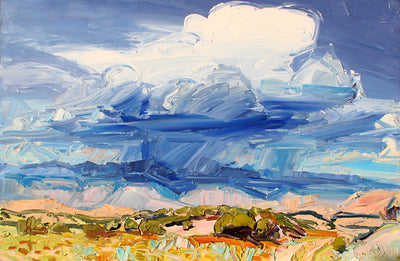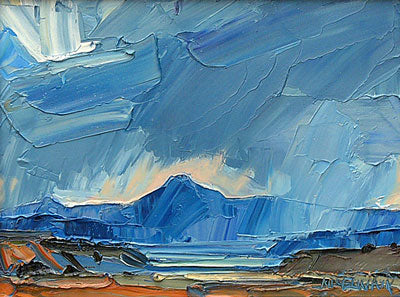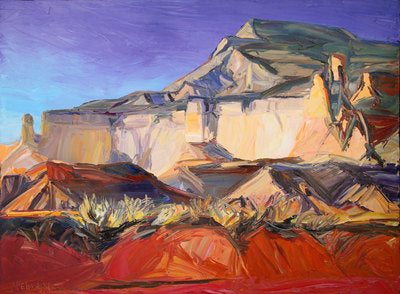Louisa McElwain, Western Art Collector October 2008
By Medicine Man Gallery on

View Louisa McElwain's available paintings
Louisa McElwain: Voice of the Desert
Reprinted courtesy of Western Art Collector, October 2008

Louisa McElwain surrounded by clouds in her studio.
Painter Louisa McElwain and nature share an intimate relationship that is best expressed on canvas. For more than 20 years she has gone out to her favorite spots to paint summer afternoon storms as they roll across the skies of New Mexico. Working outdoors under varied weather conditions allows McElwain to bring the forces of nature into her paintings, breathing life into each piece.
“For me, painting is a dance to the tempo of the evolving day,” McElwain explains. “I endeavor to be out at my favorite overlook above the badlands near Chimayo, New Mexico, and ready to paint as the clouds erupt into towering cumulus erections. A frenzy of painting I liken to a sword fight (I use palette knives and masonry trowels, rather than brushes) ensues as torrents of rain merge the earth and sky in a union almost too intimate to behold!”

Louisa McElwain, Crescendo, Oil on Canvas, 40" x 60"
Inspiration for McElwain’s latest body of work stems from this summer ritual in which the sky with thunderheads erupting becomes her next composition. As the clouds begin to crack, McElwain grabs her loaded trowel that is lashed to a stick to reach the top of the canvas, often over 8 feet off the ground, that’s attached to the back of her pickup and pushes the paint onto the fabric. She likens the sensation of energy surging through her to that of American athlete Andre Agassi smashing a tennis ball.
“Where did that come from? I often wonder when I get a chance to look at the painting in the studio,” she reflects. “ I love the big sky paintings because they are so much fun to make, so demanding physically, like ‘extreme’ painting.”

Louisa McElwain, Veils, Oil on Canvas, 12" x 16"
“I am consciously pushing the abstract quality of ‘mark making’ as I explore my relationship with the medium of oil paint on canvas,” says McElwain. “Oil paint is an intensely sensuous material on a ‘plastic’ level, and with the dimension of color added to it, I find myself working in an ecstatic state I think of as ‘play.” McElwain’s landscapes evoke a strong personal response from viewers for their thrilling sensual quality and for the unique way they articulate what works cannot. Using a style that she calls “post modern Romantic abstraction,” McElwain captures the beauty of Western landscapes that’s seldom depicted among artists today.

Louisa McElwain, Chamisa, Arroyo Seco, Oil on Canvas, 28" x 68"
“I notice that my contemporaries are a lot more conventional in terms of the use of paint. I see very few taking risks. I see very little joy or trust and a great deal of concern about being right, looking good and selling, or not selling,” says McElwain. “Most distressing to me are those who believe that my use of palette knives is what makes my work sell and try to do the same, thinking it’s about technique.”
It’s evident in her finished paintings, and in the choice of subject matter, that McElwain is a risk-taker. It’s also apparent that she loves nature and rejoices in conveying the beauty of Creation. Her passion speaks to a broad range of collectors, including young couples buying art for the first time as well as sophisticated art patrons. Her work hangs in private and corporate collections throughout the U.S. and Europe.
“I hear how my paintings are a pleasurable part of their daily lives; the first thing they look at when the sun comes up, or when they enter their home, or sit on the couch,” McElwain says.”

Louisa McElwain, Red Draw, Shining Stone, Oil on Canvas, 54" x 72"